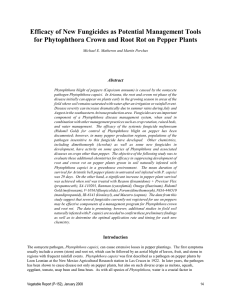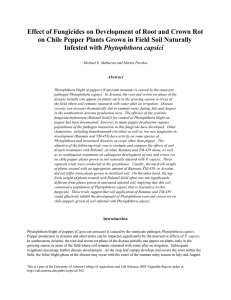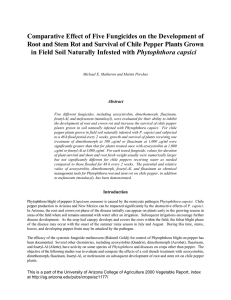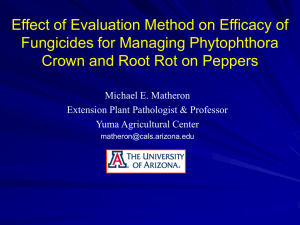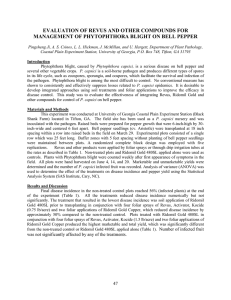Evaluation of Fungicides as Potential Management Tools Abstract
advertisement
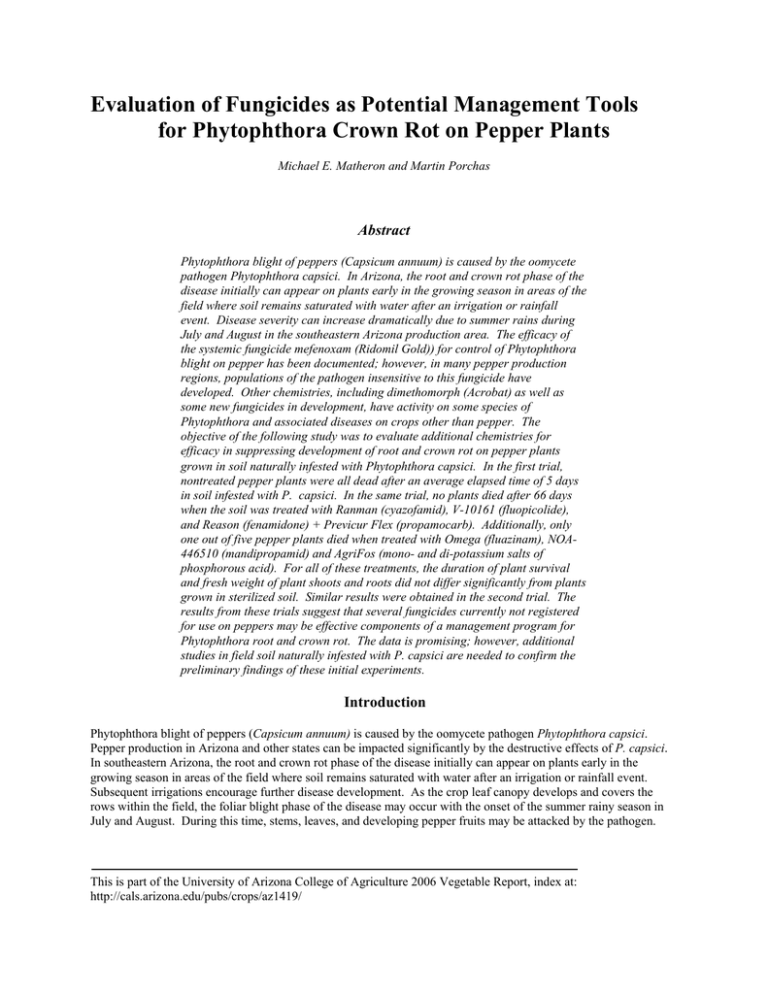
Evaluation of Fungicides as Potential Management Tools for Phytophthora Crown Rot on Pepper Plants Michael E. Matheron and Martin Porchas Abstract Phytophthora blight of peppers (Capsicum annuum) is caused by the oomycete pathogen Phytophthora capsici. In Arizona, the root and crown rot phase of the disease initially can appear on plants early in the growing season in areas of the field where soil remains saturated with water after an irrigation or rainfall event. Disease severity can increase dramatically due to summer rains during July and August in the southeastern Arizona production area. The efficacy of the systemic fungicide mefenoxam (Ridomil Gold)) for control of Phytophthora blight on pepper has been documented; however, in many pepper production regions, populations of the pathogen insensitive to this fungicide have developed. Other chemistries, including dimethomorph (Acrobat) as well as some new fungicides in development, have activity on some species of Phytophthora and associated diseases on crops other than pepper. The objective of the following study was to evaluate additional chemistries for efficacy in suppressing development of root and crown rot on pepper plants grown in soil naturally infested with Phytophthora capsici. In the first trial, nontreated pepper plants were all dead after an average elapsed time of 5 days in soil infested with P. capsici. In the same trial, no plants died after 66 days when the soil was treated with Ranman (cyazofamid), V-10161 (fluopicolide), and Reason (fenamidone) + Previcur Flex (propamocarb). Additionally, only one out of five pepper plants died when treated with Omega (fluazinam), NOA446510 (mandipropamid) and AgriFos (mono- and di-potassium salts of phosphorous acid). For all of these treatments, the duration of plant survival and fresh weight of plant shoots and roots did not differ significantly from plants grown in sterilized soil. Similar results were obtained in the second trial. The results from these trials suggest that several fungicides currently not registered for use on peppers may be effective components of a management program for Phytophthora root and crown rot. The data is promising; however, additional studies in field soil naturally infested with P. capsici are needed to confirm the preliminary findings of these initial experiments. Introduction Phytophthora blight of peppers (Capsicum annuum) is caused by the oomycete pathogen Phytophthora capsici. Pepper production in Arizona and other states can be impacted significantly by the destructive effects of P. capsici. In southeastern Arizona, the root and crown rot phase of the disease initially can appear on plants early in the growing season in areas of the field where soil remains saturated with water after an irrigation or rainfall event. Subsequent irrigations encourage further disease development. As the crop leaf canopy develops and covers the rows within the field, the foliar blight phase of the disease may occur with the onset of the summer rainy season in July and August. During this time, stems, leaves, and developing pepper fruits may be attacked by the pathogen. This is part of the University of Arizona College of Agriculture 2006 Vegetable Report, index at: http://cals.arizona.edu/pubs/crops/az1419/ Fungicides are an important component of a Phytophthora disease management system, when used in combination with other management practices such as crop rotation, raised beds, and water management. The number of available fungicides are limited. Populations of P. capsici in many growing areas have become resistant to Ridomil Gold (mefenoxam). Another fungicide, Acrobat (dimethomorph), has been shown to be an effective compound against this pathogen. There is a definite need for more fungicides to incorporate in an integrated disease management plan. The objective of the following study was to evaluate additional chemistries for efficacy in suppressing development of root and crown rot on pepper plants grown in soil naturally infested with Phytophthora capsici. Materials and Methods This study was conducted to assess the ability of some fungicides active against oomycete plant pathogens to control the development of Phytophthora root and crown rot on bell peppers caused by P. capsici when applied to soil. Naturally infested soil was collected from around diseased chile pepper plants within a field planting in southeastern Arizona and transported to a greenhouse at the Yuma Agricultural Center. Five parts of this naturally infested soil was thoroughly mixed with 2 parts sand in a large container, then dispensed into a series of 1-pint capacity plastic pots. A bell pepper seedling (approximately 3 inches tall) was transplanted into the soil within each pot, after which one of the various chemical treatments was applied by drenching the soil within each container with 200 ml of a solution of each chemistry to be evaluated. Each treatment was evaluated on five replicate plants. Two sets of control treatments were established; pepper plants grown either in nontreated field soil or heat sterilized field soil. A second application of chemical treatments was performed one month later. Each pot containing a pepper plant was placed in a container (4 inches in diameter x 1.5 inches deep), which was filled with water daily to maintain wet soil conditions that favor development of Phytophthora root and crown rot on pepper. Plants were maintained in the greenhouse for the duration of the trial. The experiment was terminated after about two months. The following data was collected either during or at the end of the experiment: i) time in days from initiation of the experiment until a plant permanently wilted (duration of plant survival), ii) fresh weight of plant shoots and roots, and iii) the incidence of crown rot. This experiment was conducted two times, with the initiation and termination dates of each trial as follows: first trial, Sep 26 to Dec 1; second trial, Oct 20 to Dec 13. Results and Discussion The results of each trial are presented in the following data tables. Disease severity in general was higher in the first trial, likely due to higher soil temperatures, compared to the second trial. In the first trial, nontreated pepper plants were all dead after an average elapsed time of 5 days in soil infested with P. capsici. In the same trial, no plants died after 66 days when the soil was treated with Ranman (cyazofamid), V-10161 (fluopicolide), and Reason (fenamidone) + Previcur Flex (propamocarb). Additionally, only one out of five pepper plants died when treated with Omega (fluazinam), NOA-446510 (mandipropamid) and AgriFos (mono- and di-potassium salts of phosphorous acid). For all of these treatments, the duration of plant survival and fresh weight of plant shoots and roots did not differ significantly from plants grown in sterilized soil. In comparison, plants treated with Ridomil Gold did differ significantly from those grown in sterilized soil with respect to survival and growth, suggesting that the population of P. capsici in this soil was insensitive to this fungicide. In the second trial, where disease severity was less intense than in the first trial, nontreated pepper plants were all dead in a average elapsed time of 13 days after planting in soil infested with the pathogen. On the other hand, no plants died after 54 days when soil was treated with an appropriate rate of Ranman, V-10161, Reason + Previcur Flex, NOA-446510, AgriFos, TM-459, and ProPhyt (potassium phosphite). Furthermore, only one out of five pepper plants died when treated with Forum (dimethomorph) and Omega. Bell pepper plant survival and growth when treated with these fungicides did not differ from that of plants grown in sterilized soil. The results from these trials suggest that several fungicides currently not registered for use on peppers may be effective components of a management program for Phytophthora root and crown rot. The data is promising; however, additional studies in field soil naturally infested with P. capsici are needed to confirm the preliminary findings of these initial experiments. Additional rates for some of these materials should also be evaluated to ascertain the optimal rate for disease management without incurring phytotoxicity issues. Further demonstration of efficacy should encourage some of the manufacturers of tested developmental products to pursue registration on peppers. 2005 bell pepper Phytophthora root and crown rot fungicide evaluation study. First trial 1 Michael Matheron and Martin Porchas, The University of Arizona, Yuma Agricultural Center, Yuma, AZ Treatment 2 Rate of product per plant Duration of plant survival 3 Fresh weight (g) Shoots Roots % of plants with crown rot Sterilized soil ------- 66 10.6 6.2 0 Ranman (400SC) 0.01 ml 66 11.2 4.6 0 Ranman (400SC) 0.02 ml 66 11.7 6.4 0 V-10161 4FL 2.0 ml 66 10.5 6.3 0 V-10161 4FL 4.0 ml 66 7.6 3.1 0 Reason + Previcur Flex 0.028 ml + 0.065 ml 66 11.5 8.0 0 Omega (500F) 0.08 ml 64 8.5 4.7 20 NOA 446510 (250SC) 0.027 ml 64 9.3 6.3 20 AgriFos 2.0 ml 64 9.4 4.3 20 AgriFos 1.0 ml 57 10.0 5.8 20 Forum 0.02 ml 52 8.0 3.3 40 TM-459 (200SC) 0.027 ml 35 4.9 4.7 60 Ridomil Gold EC 0.054 ml 33 1.9 0.7 80 TM-459 (200SC) 0.014 ml 32 4.4 2.4 60 ProPhyt 0.326 ml 30 6.5 3.3 60 5 0.4 0.1 100 3.3 ----- Untreated soil LSD (P=0.05) ------4 17 5.4 1. This trial was initiated Sep 26 and terminated Dec 1, 2005. The recorded range and mean soil temperature in °F at the 4-inch depth during the course of the trial was as follows: range 45 to 104, mean 78°F. 2. Plants were treated when transplanted into field soil naturally infested with Phytophthora capsici in the greenhouse (the beginning of the experiment), then again one month later. Sterilized soil was autoclaved for 60 minutes at 250 °F and at a pressure of 15 p.s.i. 3. Each value represents the average elapsed time in days from initiation of the experiment to death of plants. Plants were considered dead when leaves wilted permanently. This trial was terminated after 66 days. 4. Each value is the mean from five replicate plants. Values in each column differing by more than the LSD value (Least Significant Difference) are significantly different (at P = 0.05). 2005 bell pepper Phytophthora root and crown rot fungicide evaluation study. Second trial 1 Michael Matheron and Martin Porchas, The University of Arizona, Yuma Agricultural Center, Yuma, AZ Treatment 2 Rate of product per plant Duration of plant survival 3 Fresh weight (g) Shoots Roots % of plants with crown rot Sterilized soil ------- 54 18.1 8.6 0 Ranman (400SC) 0.02 ml 54 17.1 15.5 0 V-10161 4FL 2.0 ml 54 22.8 6.8 0 V-10161 4FL 4.0 ml 54 14.3 9.9 0 Reason + Previcur Flex 0.028 ml + 0.065 ml 54 18.2 11.2 0 NOA 446510 (250SC) 0.027 ml 54 12.7 7.5 0 AgriFos 2.0 ml 54 17.6 8.7 0 AgriFos 1.0 ml 54 19.9 10.1 0 TM-459 (200SC) 0.014 ml 54 20.0 11.1 0 TM-459 (200SC) 0.027 ml 54 18.7 9.1 0 ProPhyt 0.326 ml 54 17.0 10.6 0 Ridomil Gold EC 0.054 ml 52 13.2 3.7 40 Forum 0.02 ml 48 14.3 10.8 20 Omega (500F) 0.08 ml 46 15.6 12.3 20 Ranman (400SC) 0.01 ml 38 10.9 8.7 40 Untreated soil ------- 13 0.6 0.1 100 LSD (P=0.05) 4 12 6.6 5.0 ------ 1. This trial was initiated Oct 20 and terminated Dec 13, 2005. The recorded range and mean soil temperature in °F at the 4-inch depth during the course of the trial was as follows: range 43 to 102, mean 64°F. 2. Plants were treated when transplanted into field soil naturally infested with Phytophthora capsici in the greenhouse (the beginning of the experiment), then again one month later. Sterilized soil was autoclaved for 60 minutes at 250 °F and at a pressure of 15 p.s.i. 3. Each value represents the average elapsed time in days from initiation of the experiment to death of plants. Plants were considered dead when leaves wilted permanently. This trial was terminated after 54 days. 4. Each value is the mean from five replicate plants. Values in each column differing by more than the LSD value (Least Significant Difference) are significantly different (at P = 0.05).
